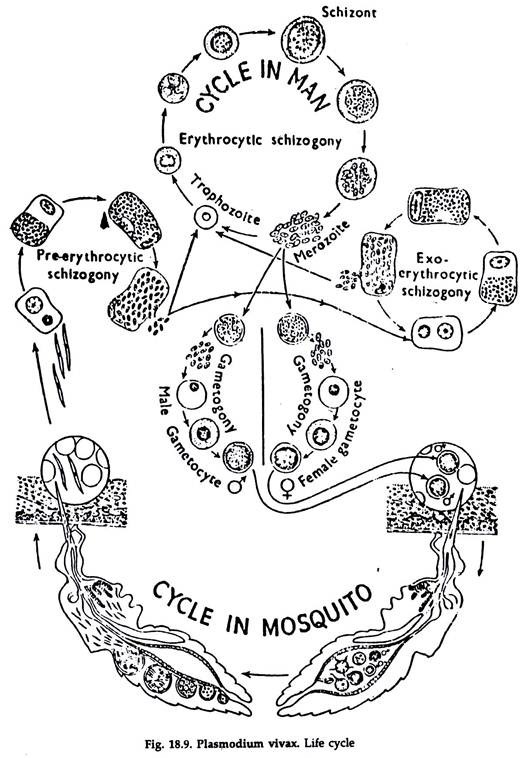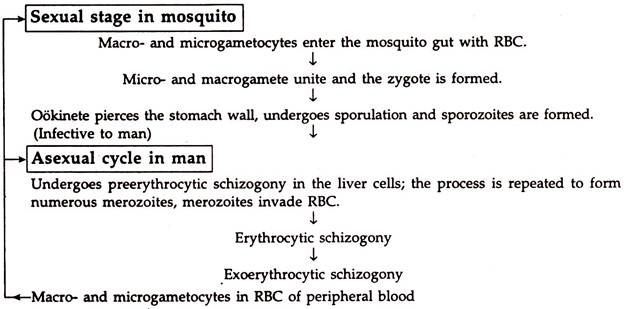In this article we will discuss about the life cycle of plasmodium vivax in man and mosquito, explained with the help of suitable diagrams.
Life Cycle and Reproduction:
Malaria parasites of man pass through two stages in their life cycle—an extrinsic phase in Anopheles mosquito and an intrinsic phase in man (Fig. 18.9). The extrinsic phase in which sexual reproduction occurs, is referred to as definitive and the intrinsic phase, with asexual reproduction, as intermediate.
ADVERTISEMENTS:
Invertebrate Phase:
During its blood meal from an infected person, the female Anopheles ingests both asexual and sexual forms but only the sexual forms survive and develop, while the rest die immediately. In the gut of a susceptible mosquito the mature macro-gametocytes (female) and microgametocytes (male) quickly mature into gametes. The first phase of development starts in the midgut (stomach) of the mosquito.
Formation of macrogamete:
ADVERTISEMENTS:
The macro-gametocyte develops into macrogamete and its nucleus shifts to the surface where a projection is formed. Only one rounded macrogamete is formed from one macro-gametocyte.
Formation of microgamete:
Microgametocyte undergoes multiple nuclear division and mature by ex-flagellation. Within 10-12 minutes 5-8 threadlike microgametes break away from red blood cell sucked by the mosquito from man and become motile.
Zygote:
ADVERTISEMENTS:
In fertilization, a microgamete penetrates the projection of the macrogamete and the zygote is formed. This is completed within 20 minutes to 2 hours in the mosquito.
Formation of sporozoite:
1. The zygote puts out a pseudopodium and forms a fusiform body, the ookinete or a travelling vermicule stage.
2. The ookinete grows and penetrates the brush border and body of a midgut epithelial cell and comes to rest, where it is transformed into a spherical mass or oocyst, surrounded by a cyst wall.
3. The oocyst is 6-12 µm in diameter, which increases from 6 to 60 µm.
4. The nucleus divides repeatedly and ultimately a large number of sickle-shaped sporozoites are formed from one oocyst.
5. The oocyst ruptures on or about 10th day of infection and the sporozoites are released in the body cavity (haemocoel) of mosquito.
6. Vivax sporozoites are narrow, slightly curved and measures about 14 µm in length.
7. Sporozoites are distributed to various organs and tissues of mosquito, but due to their affinity for salivary glands, attack them in large number and numerous sporozoites reach the salivary glands.
ADVERTISEMENTS:
8. Malarial infection may be transmitted to a new host by a single bite of such a mosquito.
Human phase:
Exoerythrocytic Schizogony or Pre-erythrocytic Schizogony and release of exoerythrocytic merozoites:
1. Bite of an infected female Anopheles allows the entry of sporozoites in human blood. Sporozoites leave the blood stream within one hour and enter reticuloendothelial cells of liver.
2. The sporozoite becomes round or oval, about 40 µm in diameter, with somewhat clumped cytoplasm, irregular nucleus and relatively long vacuoles after 8 days.
3. The nucleus undergoes multiple division, vacuoles and clumps disappear and the cytoplasm condenses around nuclear particles, giving rise to as many as 10,000 merozoites.
4. The merozoites are spherical, 1-2 µm in diameter and, being released, they make their way to host’s circulation.
A dormant or secondary erythrocytic schizoite or hypnozoite occurs in P. vivax and P. ovale, with one or two or more generations of exocrythrocytic merozoites. This hypnozoitic cycle may persist in liver with a period of latency for several years.
Erythrocytic stages:
The exoerythrocytic merozoites enter erythrocytes and reticulocytes. The merozoite possesses a selectively adhesive surface for attachment to the erythrocyte (Bannister, 1977), and an apical complex of rhoptries, micronucleus and a polar ring for invasion and usual metabolic organelles, such as rhibosomes, nuclear complex and other structures.
As the apical complex of the merozoite is attached to the red blood cell membrane, a parasitophorous vacuole develops, where merozoite is engulfed. At this time, the outer coat of the merozoite disappears.
Trophozoite:
In the red cell the merozoite is vacuolated, ring-shaped, more or less amoeboid and uninucleate. It is now called trophozoite, a name it retains until its nucleus begins to divide. The trophozoite measures 2.5 to 3 µm and consists of a cytoplasmic ring, thicker on one side, a chromatin dot (nucleus) and a vacuole. It is active and constantly sends out pseudopodia.
It feeds on haemoglobin, which it does not metabolize. The residue of globin and an iron porphyrin haematin, which is called malaria pigment (a compound of haematin, ferrihaemic acid and protein).
A coarse brick-red stripping of the cytoplasm, known as Schiiffner’s dots, appear. According to Aikawa. et. al. (1966) the parasite has a specific cytostome that ingests host cell cytoplasm, while Ladda (1966) considered the single food ingesting organelle resembling the micropyle.
Schizont:
The trophozoite becomes full grown after about 36-40 hours. All amoeboid activities are lost, the parasite assumes round shape and measures 9-10 µm. The vacuole disappears and the mature schizont is formed. In the next 6-8 hours the mature schizont undergoes erythrocytic schizogony; the nucleus divides and, subsequently, 12-18 daughter individuals, the erythrocytic merozoites are produced.
The merozoites arrange themselves in the form of a ‘rosette’. The red blood cell can no more hold the parasites, it bursts and merozoites released in the blood stream. The release of merozoites are is associated with the rise of body temperature of the host.
Erythrocytic merozoites:
The parasite is oval in shape, measures 0.5 µm in width and contains a central chromatin. Following release in blood stream many are destroyed by the immune system of the host, but some invade new red blood cells and the cycle is repeated in every 48 hours.
Gametogony:
Certain schizonts are modified for sexual reproduction and the resulting merozoites instead of undergoing schizogony change into sexual form known as gametocytes.
1. The earliest gametocyte of P. vivax is round or oval with cytoplasm taking up blue stain.
2. The gametocyte bears a spherical mass of chromatin that stains deep red or violet.
3. The microgametocyte measures 9-10 µm in size and when fully developed fills the erythrocyte.
a. It contains a large nucleus in which granules or fine fibrils of chromatin are arranged in the form of a spindle.
4. The chromatin may be divided into several masses, collected near the periphery in those, which are about to undergo ex-flagellation.
5. The microgametocytes undergoing ex-flagellation are irregular, pale blue bodies, from which several long thread-like red or violet flagellated objects, the microgamete’s project. Pigment is in an irregular mass and deep red staining chromatin is abundant.
6. The macro-gametocytes are 10-12 µm in size. It has a smaller nucleus than that of microgametocyte and chromatin is arranged in a compact mass near the periphery. The cytoplasm stains bright blue and chromatin deep red or violet.
The micro- and macro-gametocytes are sucked in by the female Anopheles during its blood meal and the life cycle of P. vivax is completed.

